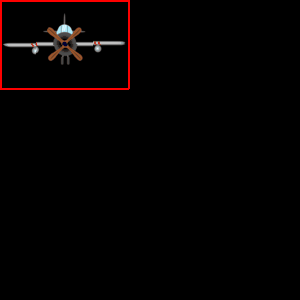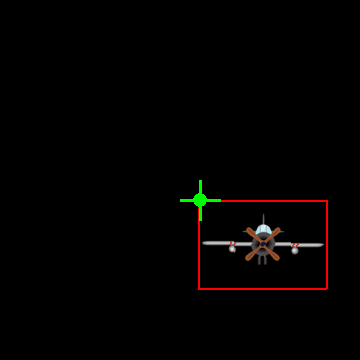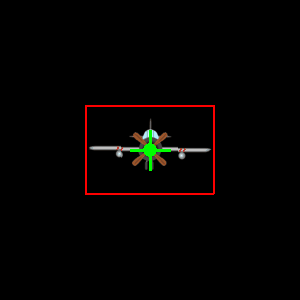如何使用Pygame围绕中心旋转图像?
我一直在尝试用 pygame.transform.rotate() 来围绕图像的中心旋转它,但总是出问题。具体来说,出问题的地方是 rot_image = rot_image.subsurface(rot_rect).copy()。我遇到了一个异常错误:
ValueError: subsurface rectangle outside surface area
下面是用来旋转图像的代码:
def rot_center(image, angle):
"""rotate an image while keeping its center and size"""
orig_rect = image.get_rect()
rot_image = pygame.transform.rotate(image, angle)
rot_rect = orig_rect.copy()
rot_rect.center = rot_image.get_rect().center
rot_image = rot_image.subsurface(rot_rect).copy()
return rot_image
7 个回答
这个回答有一些问题:我们需要在函数中获取之前矩形的位置,这样才能把它赋值给新的矩形,比如:
rect = new_image.get_rect(center=rect.center)
在另一个回答中,位置是通过从原始图像创建一个新的矩形来获得的,但这样的话,它会被放在默认的(0, 0)坐标位置。
下面的例子应该能正确工作。新的矩形需要旧矩形的center位置,所以我们也把它传递给函数。然后旋转图像,调用get_rect来获取一个大小正确的新矩形,并把旧矩形的center属性作为center参数传入。最后,返回旋转后的图像和新的矩形,作为一个元组,并在主循环中解包它。
import pygame as pg
def rotate(image, rect, angle):
"""Rotate the image while keeping its center."""
# Rotate the original image without modifying it.
new_image = pg.transform.rotate(image, angle)
# Get a new rect with the center of the old rect.
rect = new_image.get_rect(center=rect.center)
return new_image, rect
def main():
clock = pg.time.Clock()
screen = pg.display.set_mode((640, 480))
gray = pg.Color('gray15')
blue = pg.Color('dodgerblue2')
image = pg.Surface((320, 200), pg.SRCALPHA)
pg.draw.polygon(image, blue, ((0, 0), (320, 100), (0, 200)))
# Keep a reference to the original to preserve the image quality.
orig_image = image
rect = image.get_rect(center=(320, 240))
angle = 0
done = False
while not done:
for event in pg.event.get():
if event.type == pg.QUIT:
done = True
angle += 2
image, rect = rotate(orig_image, rect, angle)
screen.fill(gray)
screen.blit(image, rect)
pg.display.flip()
clock.tick(30)
if __name__ == '__main__':
pg.init()
main()
pg.quit()
这里还有一个关于旋转pygame精灵的例子。
import pygame as pg
class Entity(pg.sprite.Sprite):
def __init__(self, pos):
super().__init__()
self.image = pg.Surface((122, 70), pg.SRCALPHA)
pg.draw.polygon(self.image, pg.Color('dodgerblue1'),
((1, 0), (120, 35), (1, 70)))
# A reference to the original image to preserve the quality.
self.orig_image = self.image
self.rect = self.image.get_rect(center=pos)
self.angle = 0
def update(self):
self.angle += 2
self.rotate()
def rotate(self):
"""Rotate the image of the sprite around its center."""
# `rotozoom` usually looks nicer than `rotate`. Pygame's rotation
# functions return new images and don't modify the originals.
self.image = pg.transform.rotozoom(self.orig_image, self.angle, 1)
# Create a new rect with the center of the old rect.
self.rect = self.image.get_rect(center=self.rect.center)
def main():
screen = pg.display.set_mode((640, 480))
clock = pg.time.Clock()
all_sprites = pg.sprite.Group(Entity((320, 240)))
while True:
for event in pg.event.get():
if event.type == pg.QUIT:
return
all_sprites.update()
screen.fill((30, 30, 30))
all_sprites.draw(screen)
pg.display.flip()
clock.tick(30)
if __name__ == '__main__':
pg.init()
main()
pg.quit()
你正在删除rotate创建的矩形。你需要保留这个矩形,因为它在旋转时会改变大小。
如果你想保持这个对象的位置,可以这样做:
def rot_center(image, angle):
"""rotate a Surface, maintaining position."""
loc = image.get_rect().center #rot_image is not defined
rot_sprite = pygame.transform.rotate(image, angle)
rot_sprite.get_rect().center = loc
return rot_sprite
# or return tuple: (Surface, Rect)
# return rot_sprite, rot_sprite.get_rect()
简短回答:
当你使用 pygame.transform.rotate 来旋转图像时,旋转后的图像大小会比原始图像大。你需要确保旋转后的图像中心仍然在未旋转图像的中心位置。为此,先获取原始图像的矩形区域,然后设置位置。接着获取旋转图像的矩形区域,并通过原始矩形的中心来设置位置。
这个函数 red_center 会返回一个元组,包含旋转后的图像和旋转图像的边界矩形:
def rot_center(image, angle, x, y):
rotated_image = pygame.transform.rotate(image, angle)
new_rect = rotated_image.get_rect(center = image.get_rect(center = (x, y)).center)
return rotated_image, new_rect
或者你可以写一个函数来旋转并 .blit 图像:
def blitRotateCenter(surf, image, topleft, angle):
rotated_image = pygame.transform.rotate(image, angle)
new_rect = rotated_image.get_rect(center = image.get_rect(topleft = topleft).center)
surf.blit(rotated_image, new_rect)
详细回答:
图像(pygame.Surface)可以通过 pygame.transform.rotate 来旋转。
如果在一个循环中逐步旋转图像,图像会变形并迅速增大:
while not done:
# [...]
image = pygame.transform.rotate(image, 1)
screen.blit(image, pos)
pygame.display.flip()
这是因为旋转图像的边界矩形总是比原始图像的边界矩形大(除了每90度的旋转)。
图像变形是因为多次复制。每次旋转都会产生一个小误差,误差的总和在不断增加,导致图像质量下降。
可以通过保留原始图像,并只用一次旋转操作生成的图像来解决这个问题。
angle = 0
while not done:
# [...]
rotated_image = pygame.transform.rotate(image, angle)
angle += 1
screen.blit(rotated_image, pos)
pygame.display.flip()
现在图像似乎在随意改变位置,因为图像的大小因旋转而变化,而原点始终是图像边界矩形的左上角。
可以通过比较旋转前后的 轴对齐边界框 来进行补偿。
在接下来的计算中使用 pygame.math.Vector2。注意,在屏幕坐标中,y轴向下,而数学中的y轴是从下到上的。这导致在计算时需要“翻转”y轴。
设置一个包含边界框四个角点的列表:
w, h = image.get_size()
box = [pygame.math.Vector2(p) for p in [(0, 0), (w, 0), (w, -h), (0, -h)]]
通过 pygame.math.Vector2.rotate 旋转这些角点的向量:
box_rotate = [p.rotate(angle) for p in box]
获取旋转点的最小值和最大值:
min_box = (min(box_rotate, key=lambda p: p[0])[0], min(box_rotate, key=lambda p: p[1])[1])
max_box = (max(box_rotate, key=lambda p: p[0])[0], max(box_rotate, key=lambda p: p[1])[1])
通过将旋转框的最小值加到位置上,计算图像左上角的“补偿”原点。对于y坐标,max_box[1] 是最小值,因为y轴是“翻转”的:
origin = (pos[0] + min_box[0], pos[1] - max_box[1])
rotated_image = pygame.transform.rotate(image, angle)
screen.blit(rotated_image, origin)
甚至可以在原始图像上定义一个支点。计算从图像中心到支点的偏移向量并旋转这个向量。一个向量可以用 pygame.math.Vector2 表示,并可以用 pygame.math.Vector2.rotate 进行旋转。注意,pygame.math.Vector2.rotate 的旋转方向与 pygame.transform.rotate 是相反的,因此角度需要反转:
计算从图像中心到支点的向量:
image_rect = image.get_rect(topleft = (pos[0] - originPos[0], pos[1]-originPos[1]))
offset_center_to_pivot = pygame.math.Vector2(pos) - image_rect.center
旋转这个向量
rotated_offset = offset_center_to_pivot.rotate(-angle)
计算旋转后图像的中心:
rotated_image_center = (pos[0] - rotated_offset.x, pos[1] - rotated_offset.y)
旋转并将图像绘制到表面:
rotated_image = pygame.transform.rotate(image, angle)
rotated_image_rect = rotated_image.get_rect(center = rotated_image_center)
screen.blit(rotated_image, rotated_image_rect)
在下面的示例程序中,函数 blitRotate(surf, image, pos, originPos, angle) 完成了上述所有步骤,并将旋转后的图像绘制到一个表面上。
surf是目标表面image是需要旋转和绘制的表面pos是目标表面surf上支点的位置(相对于surf的左上角)originPos是支点在image表面上的位置(相对于image的左上角)angle是旋转的角度(以度为单位)
这意味着,blitRotate 的第二个参数(pos)是窗口中支点的位置,而第三个参数(originPos)是旋转 表面 上支点的位置:
最小示例:  repl.it/@Rabbid76/PyGame-RotateAroundPivot
repl.it/@Rabbid76/PyGame-RotateAroundPivot
import pygame
pygame.init()
screen = pygame.display.set_mode((300, 300))
clock = pygame.time.Clock()
def blitRotate(surf, image, pos, originPos, angle):
# offset from pivot to center
image_rect = image.get_rect(topleft = (pos[0] - originPos[0], pos[1]-originPos[1]))
offset_center_to_pivot = pygame.math.Vector2(pos) - image_rect.center
# roatated offset from pivot to center
rotated_offset = offset_center_to_pivot.rotate(-angle)
# roatetd image center
rotated_image_center = (pos[0] - rotated_offset.x, pos[1] - rotated_offset.y)
# get a rotated image
rotated_image = pygame.transform.rotate(image, angle)
rotated_image_rect = rotated_image.get_rect(center = rotated_image_center)
# rotate and blit the image
surf.blit(rotated_image, rotated_image_rect)
# draw rectangle around the image
pygame.draw.rect(surf, (255, 0, 0), (*rotated_image_rect.topleft, *rotated_image.get_size()),2)
def blitRotate2(surf, image, topleft, angle):
rotated_image = pygame.transform.rotate(image, angle)
new_rect = rotated_image.get_rect(center = image.get_rect(topleft = topleft).center)
surf.blit(rotated_image, new_rect.topleft)
pygame.draw.rect(surf, (255, 0, 0), new_rect, 2)
try:
image = pygame.image.load('AirPlaneFront.png')
except:
text = pygame.font.SysFont('Times New Roman', 50).render('image', False, (255, 255, 0))
image = pygame.Surface((text.get_width()+1, text.get_height()+1))
pygame.draw.rect(image, (0, 0, 255), (1, 1, *text.get_size()))
image.blit(text, (1, 1))
w, h = image.get_size()
angle = 0
done = False
while not done:
clock.tick(60)
for event in pygame.event.get():
if event.type == pygame.QUIT:
done = True
pos = (screen.get_width()/2, screen.get_height()/2)
screen.fill(0)
blitRotate(screen, image, pos, (w/2, h/2), angle)
#blitRotate2(screen, image, pos, angle)
angle += 1
pygame.draw.line(screen, (0, 255, 0), (pos[0]-20, pos[1]), (pos[0]+20, pos[1]), 3)
pygame.draw.line(screen, (0, 255, 0), (pos[0], pos[1]-20), (pos[0], pos[1]+20), 3)
pygame.draw.circle(screen, (0, 255, 0), pos, 7, 0)
pygame.display.flip()
pygame.quit()
exit()
另请参见 旋转表面 以及问题的答案:



